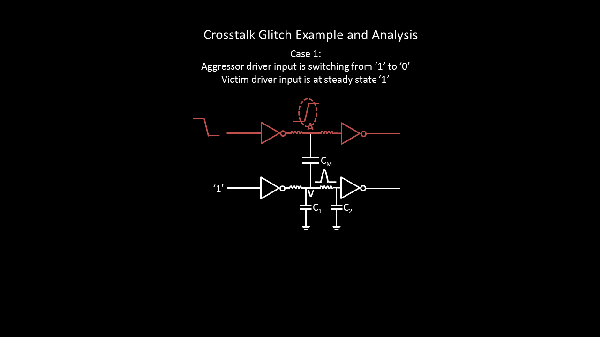Hello
Let me start this with a 30 sec video
Well …. That’s glitch … Plain and simple !!! 🙂
Ahhh…. It’s a pain … right !! I can tell you exactly, why the above happens. Stay with me!!
On a circuit, fabricated on silicon, there are trillions of wires packed in a small area, something like below, and as me and you demand for higher speed and huge number of applications, poor engineers [:(] try to pack even more devices and wires in that tiny area

Imagine a situation, where, in a room of size of about 20 people, you put 50 people, and all 50 people talk!!
No 2 people can have a meaningful conversation, as they will be disturbed by what others are talking.
Now put the below little 2 wires into the above situation and, imagine what the wires go through.
They interfere with each other, through the coupling capacitor

The stronger wire, is given the name “Aggressor (A)” and the weaker wire is given the name “Victim (V)”.
Let’s take a case, where ‘A’ switches and ‘V’ is silent, like below

When we say “rise transition”, it actually means, we are charging some capacitance, and the amount of charge the capacitance has, decides its logic value.
A fully charged capacitor, will be called ‘logic 1’ and an empty or discharged capacitor will be called ‘logic 0’.
Unfortunately, the wires here are so close, that there is another capacitance between them, and along with charges on C1 and C2, the amount of charge on Cm will also play a crucial role in deciding whether ‘V’ is at logic ‘1’ or ‘0’.
And that’s exactly what happens. The rising transition of ‘A’, charges Cm to such a level, that, for a moment, at ‘V’, the voltage rises.


And this is called a ‘rise glitch‘. This glitch can be so strong, that it might just change the functionality of the system, and I will come back on this in my next post. You know what !!
This is just the first level analysis that I shown. I will come back with a detailed analysis of this glitch and show you, that we do not have to worry, yet.
Remember the famous quote from Richard Sloma “Never try to solve all the problems at once — make them line up for you one-by-one”
Thanks
Kunal

